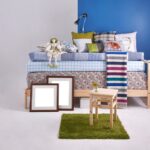Are home decorating trims different from sewing trims? Trims play a significant role in both home decorating and sewing, adding a decorative touch to various projects. When it comes to choosing the right trims for your home decor or sewing projects, it’s important to understand the differences between the two and how they are used.
In home decorating, trims are used to enhance the aesthetic appeal of curtains, pillows, lampshades, and other soft furnishings. They come in various types such as tassels, fringes, cords, and braids, adding texture and visual interest to the decor. On the other hand, sewing trims are essential for embellishing garments, accessories, and DIY crafts. These trims can include lace, ribbons, pom-poms, and rickrack among others.
Understanding the distinctions between home decorating trims and sewing trims is crucial in choosing the right materials and styles for specific projects. While both serve decorative purposes, they differ in terms of materials used, styles available, and their applications. In this article, we will explore the various types of trims used in home decorating and sewing while highlighting their unique characteristics.
We will also discuss the key differences between these two types of trims and provide insights into factors to consider when selecting trims for different purposes. Whether you’re looking to enhance your home decor or elevate your sewing projects with beautiful trimmings – this article will serve as a comprehensive guide to help you make informed decisions.
Understanding Home Decorating Trims
When it comes to home decorating, trims play a significant role in adding an extra touch of elegance and style to various elements of interior design. From curtains and pillows to lampshades and upholstery, trims can enhance the overall look of a room. Home decorating trims come in a wide variety of styles, materials, and colors, offering endless possibilities for customization.
One key aspect that sets home decorating trims apart from sewing trims is their intended use and application. While sewing trims are primarily designed for garments and fabric-based projects, home decorating trims are specifically created for adorning furniture, window treatments, and other decorative elements within the home. This distinction influences the types of materials used for each type of trim as well as their durability and resistance to wear and tear.
In addition to this difference in application, home decorating trims also tend to feature larger sizes and bolder designs compared to their sewing counterparts. These characteristics make them more suitable for making a statement in interior design projects.
Furthermore, the availability of specialized trims such as tassel fringe or cord with lip allows for unique embellishments that can instantly elevate the look of any decorative piece. With these considerations in mind, it becomes clear how home decorating trims serve a distinct purpose in enhancing the aesthetic appeal of interior spaces.
Exploring Sewing Trims
Sewing trims are an essential part of any sewing project, adding decorative elements and finishing touches to clothing, accessories, and home textiles. These trims come in a wide variety of materials, styles, and functions, making them a versatile choice for sewers looking to add flair and personality to their creations.
One key difference between home decorating trims and sewing trims is their intended use. Sewing trims are specifically designed for use in sewing projects such as garments, quilts, and other fabric items. They are often chosen for their decorative purposes as well as their ability to hide raw edges or seams. On the other hand, home decorating trims are meant for embellishing interior design elements such as curtains, pillows, lampshades, and furniture upholstery.
When it comes to sewing trims, there is no shortage of options available. From classic choices like lace and ribbons to more modern options like pom-poms and sequins, sewers have a wide array of trims to choose from. Each type of trim serves a specific purpose – some may be used for adding delicate, feminine details to garments while others may provide a bold or quirky accent.
When working with sewing trims, it’s important to consider the material used in the trim itself. Some common materials include cotton, satin, silk, velvet, or metallic threads. The material not only affects the look and feel of the trim but also its durability and how it can be incorporated into different sewing projects.
| Types of Sewing Trims | Common Materials |
|---|---|
| Lace | Cotton or Synthetic Fibers |
| Ribbon | Satin or Grosgrain |
| Pom-Poms | Yarn or Fabric |
Key Differences Between Home Decorating Trims and Sewing Trims
When it comes to trims, they play a crucial role in both home decorating and sewing projects. However, the key question that often arises is, are home decorating trims different from sewing trims? The answer lies in understanding the specific differences in materials, styles, and applications of these two types of trims.
Materials
One of the main differences between home decorating trims and sewing trims lies in the materials used. Home decorating trims are often made of more durable and heavy-duty materials such as wood, metal, or sturdy fabric. These trims are designed to withstand the wear and tear of daily use in home decor items such as curtains, lampshades, or upholstery.
On the other hand, sewing trims are typically made of lighter materials such as lace, ribbons, or delicate fabric. These trims are designed to add decorative accents to clothing items or smaller household items like pillows or table runners.
Styles
Another distinction between home decorating trims and sewing trims is evident in their styles. Home decorating trims come in a variety of bold and intricate designs that can make a statement in a room. They often have embellishments like tassels, fringes, or beading to add a touch of luxury to home decor items. In contrast, sewing trims offer more delicate and detailed styles that are meant to enhance the overall look of a garment or accessory without overpowering it.
Applications
The applications for home decorating trims differ from sewing trims due to their intended use. Home decorating trims are primarily used to embellish larger items such as curtains, drapes, or furniture upholstery. They serve both an aesthetic and functional purpose by adding flair and reinforcing seams or edges. Conversely, sewing trims are applied to clothing items like dresses, skirts, or blouses to enhance their design and create visual interest.
Factors to Consider When Choosing Trims
When choosing trims for home decorating and sewing projects, it is important to consider a variety of factors to ensure the perfect match for your intended use. Whether you are embellishing curtains, pillows, or garments, the right trim can make all the difference in achieving the desired look. Here are some important factors to consider when selecting trims for home decorating and sewing projects.
Material
One of the key factors to consider when choosing trims for home decorating and sewing is the material. Home decorating trims often include materials like tassels, cords, or fringe that are durable and designed to withstand regular handling. Sewing trims, on the other hand, may incorporate delicate materials like lace, ribbon, or beading that require special care when being stitched onto fabric.
Style and Design
The style and design of the trim are crucial considerations when selecting trims for home decorating or sewing projects. Home decorating trims are often more elaborate and ornate to complement interior decor elements such as furniture upholstery or window treatments. In contrast, sewing trims tend to be more versatile in design, with options ranging from simple edging to intricate embroidery patterns.
Application
Another important factor to consider is how the trim will be applied in your project. Home decorating trims may need to be attached using specific hardware or techniques that differ from those used in sewing applications. Understanding the intended application of the trim will help you choose one that is suitable for your project’s specific needs.
DIY Projects With Home Decorating Trims
When it comes to home decorating, trims can add a beautiful and elegant touch to various items, such as curtains, pillows, lampshades, and more. Home decorating trims come in a wide range of styles, materials, and colors, making them versatile for different types of projects. Whether you’re looking to add a classic look with braided trims or a modern touch with pom-pom trims, there are endless possibilities for using trims in home decor projects.
Here are some creative ideas and tutorials for using home decorating trims in your DIY projects:
- Create custom throw pillows by adding decorative trims to the edges for a pop of color and texture.
- Revamp old curtains by embellishing them with tassel or fringe trims to give them a fresh new look.
- Add ribbon or beaded trims to lampshades for an extra dose of glamour and sophistication.
- Embellish picture frames with fabric trims to create unique and personalized photo displays.
These DIY projects allow you to unleash your creativity and showcase your personal style through the use of home decorating trims. Whether you’re aiming for a chic and modern aesthetic or a more traditional and ornate look, there’s no limit to the ways you can incorporate trims into your home decor.
Overall, the key is to experiment with different types of trims and explore how they can elevate the look of your living space. With just a few simple techniques and some basic sewing skills, you can transform ordinary household items into stunning pieces that reflect your individual taste and flair.
Now that you have some inspiration for using home decorating trims in DIY projects, it’s time to roll up your sleeves and get creative. And remember-a little trim goes a long way in adding that perfect finishing touch to your home decor.
DIY Projects With Sewing Trims
When it comes to incorporating trims in sewing projects, there are numerous creative possibilities that can enhance the overall look of your creations. Whether you are working on clothing, accessories, or home textiles, sewing trims can add a unique and decorative touch. Here are some innovative ideas and step-by-step guides for using sewing trims to elevate your sewing projects:
- Embellished Clothing: Transform a plain t-shirt or dress by adding a row of colorful pom-pom trim to the hem or sleeves for a playful and artistic look.
- Quilt Borders: Use lace trims as borders for quilts to give them an elegant and delicate finish. This adds a beautiful touch to your quilt while also providing additional texture.
- Accent Pillows: When making accent pillows, adding a simple ribbon trim around the edges can instantly elevate the look of the pillow cover. You can mix and match different colors and patterns to create a unique design.
Incorporating sewing trims into your projects allows you to personalize your creations and showcase your individual style. Whether you prefer a minimalist approach or enjoy experimenting with bold designs, there are endless opportunities for incorporating trims into your sewing projects. With the right guidance and some creativity, you can effortlessly transform ordinary garments and home decor items into extraordinary pieces that stand out.
By exploring different types of sewing trims such as ribbons, laces, fringes, and braids, you can add depth and dimension to your projects while also showcasing attention to detail. Whether you are a beginner or experienced sewer, experimenting with sewing trims opens up new avenues for expressing your creativity through needlework. From intricate embroidery embellishments to simple yet effective edgings, the possibilities with sewing trims are truly endless.
Conclusion
In conclusion, it is evident that home decorating trims and sewing trims serve different purposes and have distinct characteristics. While home decorating trims are often used to add decorative flair and texture to upholstery, curtains, and other household items, sewing trims are primarily utilized for embellishing garments and accessories. The materials, styles, and applications of these trims are tailored to their respective functions, making them unique in their own right.
When choosing trims for home decorating or sewing projects, it is essential to consider the specific requirements of the project, such as durability, washability, and aesthetic appeal. Home decorating trims may require sturdier materials that can withstand wear and tear, while sewing trims may need to be more flexible and lightweight for comfortable wear. Understanding these differences will ensure that the chosen trims effectively enhance the overall look and functionality of the project.
In essence, whether you are embarking on a home decor makeover or diving into a sewing endeavor, selecting the right trims is crucial in achieving the desired outcome. By carefully evaluating the materials, styles, and suitability of trims for each purpose, you can elevate your projects with personalized touches that reflect your creativity and attention to detail.
So next time you find yourself pondering whether home decorating trims are different from sewing trims – remember that while they may share certain similarities in terms of decorative appeal, their distinct applications make them uniquely suited for their intended purposes.
Frequently Asked Questions
What Is Sewing Trim Called?
Sewing trim is often called “ribbon” or “binding.” It is a narrow piece of fabric, usually with a decorative edge, that is used as an embellishment on clothing, accessories, or home decor items.
What Is the Difference Between Functional and Decorative Trim?
The main difference between functional and decorative trim is their intended purpose. Functional trim, such as bias tape or piping, serves a practical function in garment construction by finishing raw edges and adding structure. Decorative trim, on the other hand, is used primarily for aesthetic purposes to enhance the visual appeal of a project.
What Is Decorative Trimming?
Decorative trimming refers to any type of ornamental embellishment that is added to a sewing project for purely decorative reasons. This can include lace, sequins, beads, embroidery, tassels, or any other decorative element that enhances the overall look of the finished piece without serving a practical function like functional trims do.

I’m thrilled to be your companion on this exciting journey through the world of home decor and design. With a passion for turning houses into homes and a keen eye for the finer details, I’m here to help you transform your living spaces into beautiful, functional, and meaningful havens.





